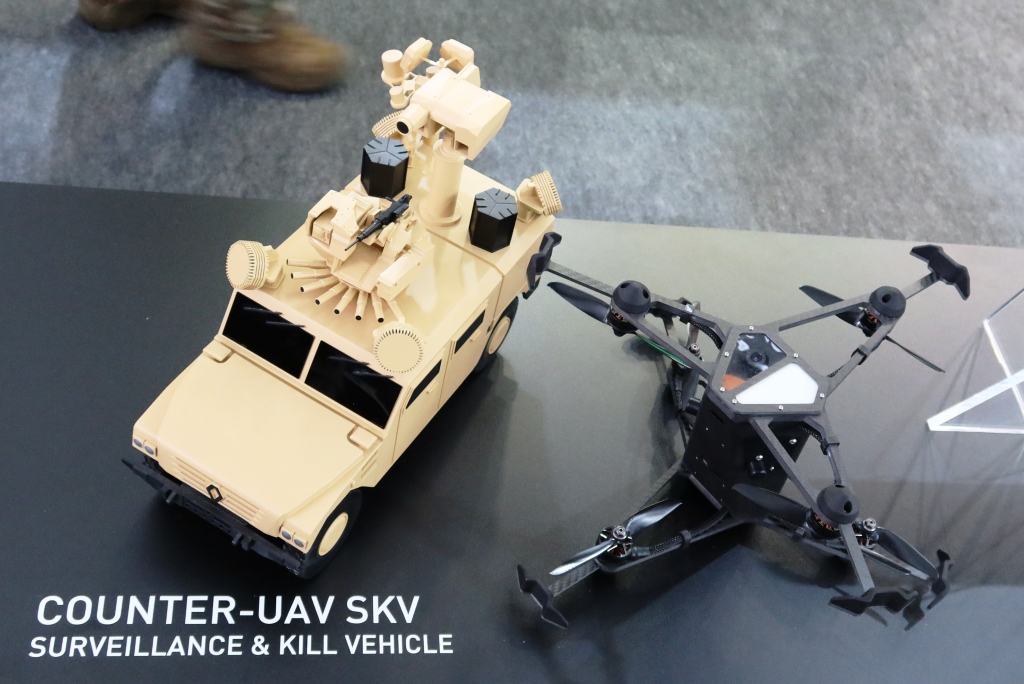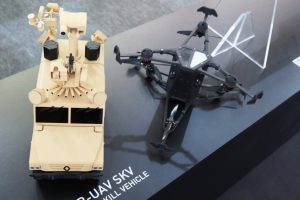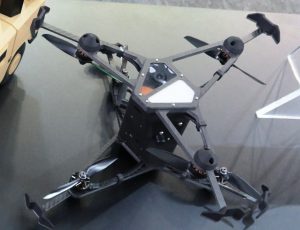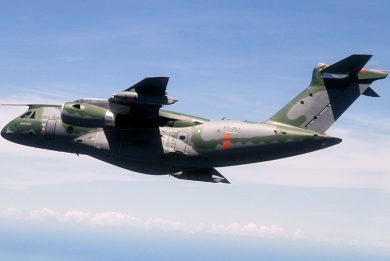
SOFINS 2023 – MBDA adds a Hit-To-Kill effector to its Sky Warden C-UAS system
A leader in countering threats coming from the third dimension, MBDA could not avoid becoming involved in the Counter-UAS (C-UAS) business, and in the past years it developed the Sky Warden, based on successive building blocks put together, most of them coming from the company while some come from third parties.
The core of the system is the command and control suite, provided by MBDA, which gets inputs from various sensors and provides solutions to the operator in terms of reaction. Among sensors used to detect and track the incoming threat we find the Giraffe 1X radar by Saab, the Rada 4D MHR being provided as alternative, the Hydra 200 passive RF sensor from Cerbair, a French SME partly owned by MBDA, and an HGH infrared and electro-optic camera, the latter ensuring short-range identification of potentially dangerous drones.

MBDA teamed with NOVADEM
Until now effectors were either non lethal; such as jammers, or lethal, such as the HELMA-P high power laser by Cilas, and the Mistral 3 missile, which would however be the last resource considering its cost, much higher than that of its potential killer, and the limited number of missiles usually available in a deployment. MBDA has therefore considered adding another hard-kill system, in the form of a killer UAS, and for this it teamed with NOVADEM, a known provider of drones of different types, with which the missile company had already carried out some programmes.
« One of the V-shaped terminals allows maintaining batteries at full load »
The new hard-kill solution is known as Surveillance & Kill Vehicle or SKV in short, and is a rotary wing drone with many peculiarities. A hexacopter, its electric motors activating two-blade rotors are fitted on arms that protrude from a body with a near triangular section, three arms being fitted at the top and bottom of the body at 120° spacing, the upper set being rotated by 60° compared to the bottom one. The body is inclined, while arms have a first part made of two spars, the motors being located where the spars come together, a single spar protruding further protecting the rotor and carrying a V-shaped terminal. This allows inserting the drone into a hexagonal container that can host up to three SKVs. Moreover, one of the V-shaped terminals allows maintaining batteries at full load and sending mission data to the killer drone. Two such containers were seen on the model vehicle exhibited at SOFINS that therefore carried six SKVs.

« The Surveillance & Kill Vehicle or SKV range is of around 2 km »
According to Novadem the SKV design comes from the need to minimise drag and maximise the speed in the terminal phase. Once launched vertically, the SKV rotates into the horizontal flight attitude, the body inclination ensuring lift while rotors become propellers. Control laws had to be developed carefully, the SKV needing high manoeuvrability in the terminal phase. In the mid-phase course the drone is guided by the launch vehicle on the ground, which follows the target with its electro-optic sensor, but when it gets at around 200-300 meters distance from the enemy drone the terminal guidance kicks in, the video processing system bringing it to impact the incoming threat, neutralising it physically. The 1 kg mass SKV hits its victim at around 200 km/h, its structure being reinforced in the hit areas, up to 5 mm thick carbonfibre elements, ensuring non-elastic impact. The SKV range is of around 2 km, endurance being limited considering speed and distance, probably only a few minutes.
The SKV is considered at TRL-6 and was demonstrated to the French MoD Defence Innovation Agency. The full development works now starts to ensure full technology maturation and to transform it in an actual product.
Back to our SOFINS 2023 full editorial coverage menu.
Photos by P. Valpolini



